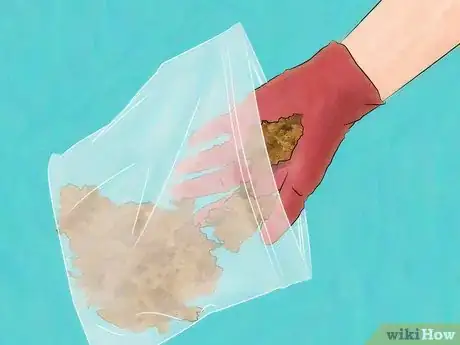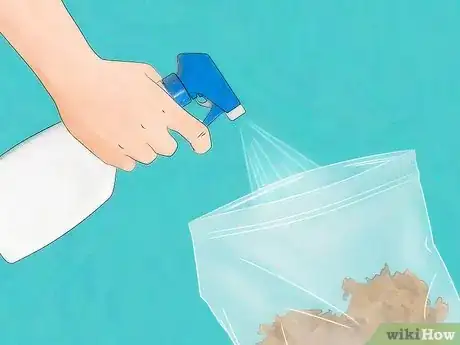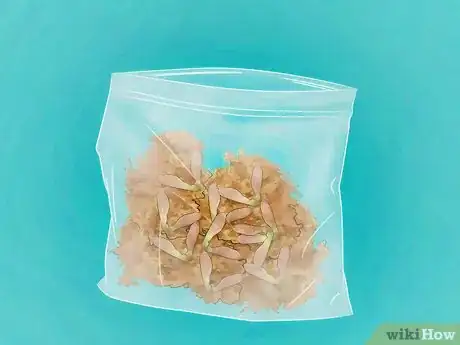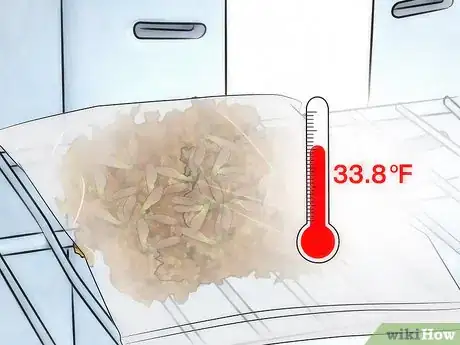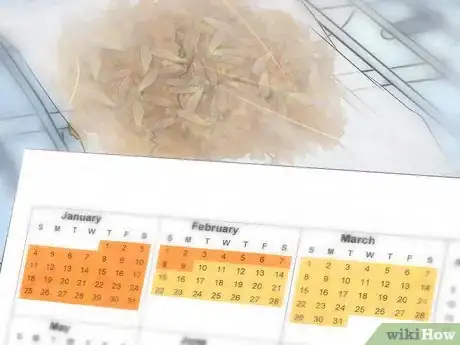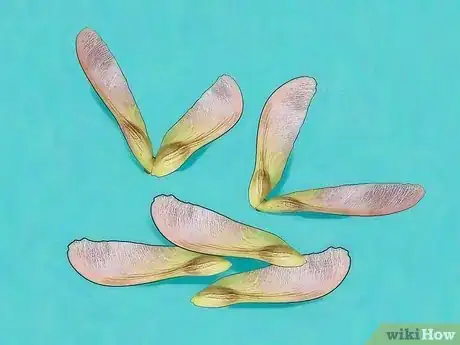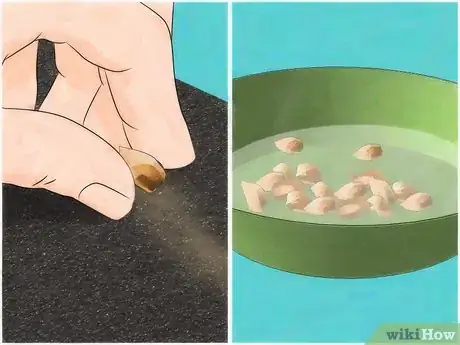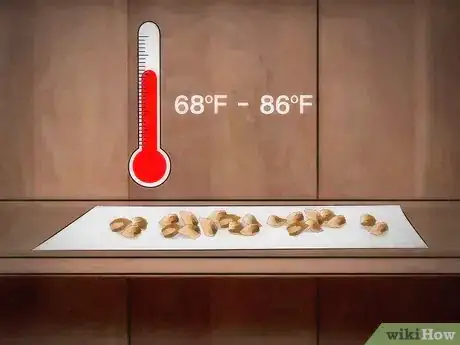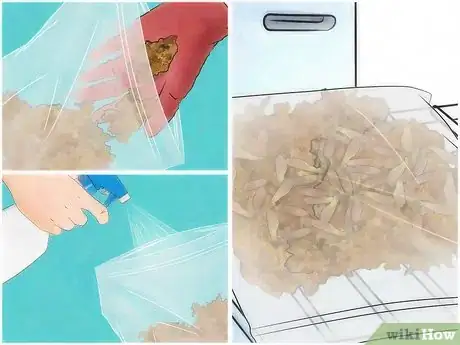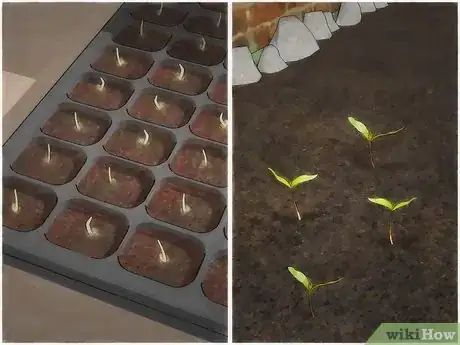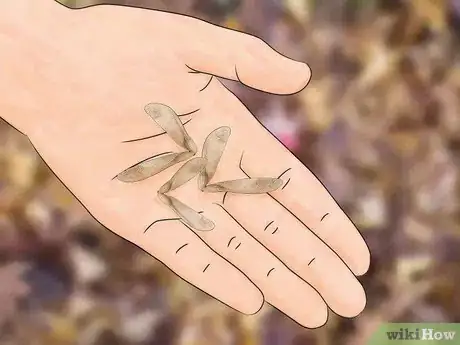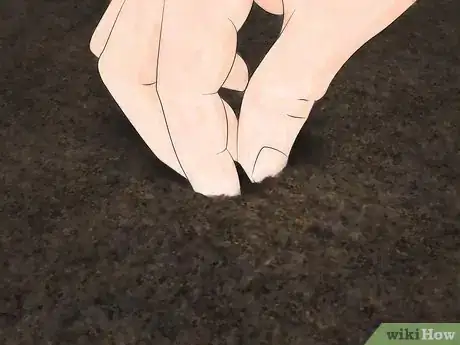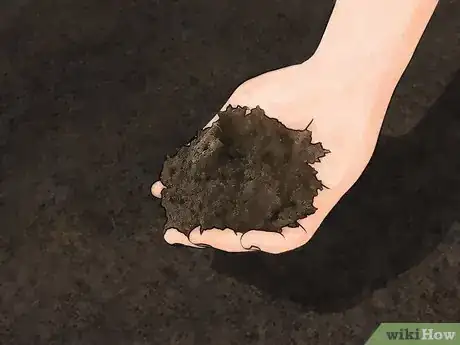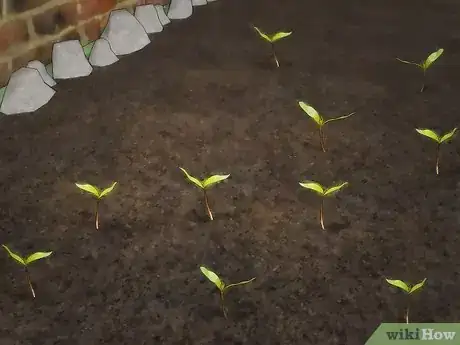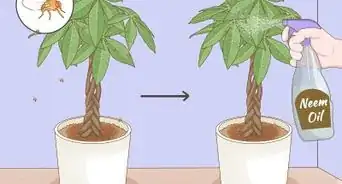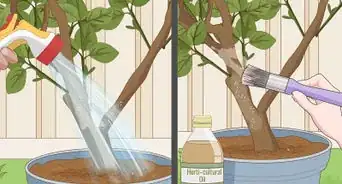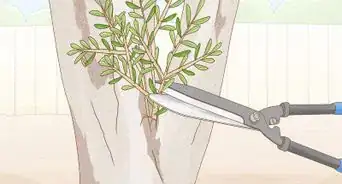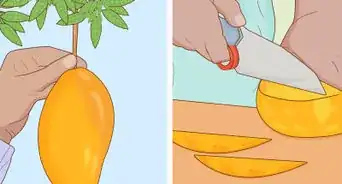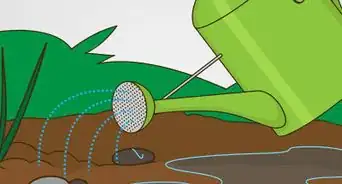This article was co-authored by Lauren Kurtz. Lauren Kurtz is a Naturalist and Horticultural Specialist. Lauren has worked for Aurora, Colorado managing the Water-Wise Garden at Aurora Municipal Center for the Water Conservation Department. She earned a BA in Environmental and Sustainability Studies from Western Michigan University in 2014.
There are 9 references cited in this article, which can be found at the bottom of the page.
wikiHow marks an article as reader-approved once it receives enough positive feedback. This article received 11 testimonials and 90% of readers who voted found it helpful, earning it our reader-approved status.
This article has been viewed 401,211 times.
There are many species of maple tree, and no one-size-fits-all approach to growing them from seed. Some species are easy to plant, especially the ones that disperse seeds in spring or early summer. Others are so difficult and picky that even professional foresters can only reach 20–50% germination rates. If possible, identify your maple species before you begin. If you cannot, try the cold stratification method.
Steps
Using Cold Stratification
-
1Try this for most maple seeds. Sugar maples, bigleaf maples, boxelder maples, Japanese maples, Norway maples, and some red maples lie dormant over the winter, then germinate as soon as temperatures warm. The cold stratification approach produces very high germination rates in these species.[1]
- All of these species drop their seeds in autumn or early winter. If your red maple trees drop their seeds in spring or early summer, try germinating them in the soil instead.
- If you're going to plant the seeds outdoors, start this method 90–120 days before the last winter frost.
-
2Fill a plastic bag with growing material. Place a handful of peat moss, vermiculite, or germination paper in a small, plastic, zip-locked bag. For best results, use sterile material and handle it with disposable gloves to avoid introducing fungus.Advertisement
-
3Add a little water. Add a couple drops of water to the growing material to dampen the material slightly. If you see standing water, or if you can squeeze out water from the material, it is too wet.
-
4Apply a little fungicide (optional). Fungicide can prevent mold from destroying your seeds, but it is not always necessary, and may damage the plant if overused. Add only in tiny quantities, following manufacturer's instructions.
- Some growers rinse the seeds in very diluted bleach solutions instead.
-
5Add the seeds and close the bag. Place your seeds in the bag. Starting from the base, roll the bag to expel most of the air. Zip it closed.
-
6Store in the refrigerator. Now it's time to "stratify" the seeds, or expose them to temperatures that trigger germination. For most species, the ideal temperature is usually around 1–5ºC (33.8–41ºF).[4] The crisper drawer of a refrigerator is usually about this temperature.
- Ideally, use a thermometer to confirm the correct temperature. Some seeds may fail to germinate if the temperature is just a couple degrees off.
- If possible, keep boxelder and Norway maple seeds at exactly 5ºC (41ºF), and red maple seeds at exactly 3ºC (37.4ºF).[5] [6] Other species are not as picky.
-
7Leave them for 40–120 days, checking every week or 2. Most of these species take 90–120 days to germinate, but the bigleaf maple and a few others can sprout in as few as 40.[7] Every week or 2, check on the bag and make adjustments as needed:
- If you notice condensation, pick up the bag and gently tap it to knock the water droplets off. Lay the bag back down on the opposite side, so the wet seeds have a chance to dry off.
- If the growing material has dried out, add a drop or 2 of water.
- If you notice any mold or black spots, remove the affected seed and throw it away. (If the whole batch is molding, try a little fungicide.)
- If the seeds have begun to sprout, remove them from the refrigerator.
-
8Plant the seeds. Once the seeds have germinated, plant them 0.6–1.2cm (¼–½ inch) under moist soil. Most maples do well in partial shade, but look up the exact species if possible for more info on planting.
- To increase the odds of survival, start the seedlings in an indoor seed tray instead. Fill the tray with 7.6–10 cm (3–4 inches) of well-draining potting soil, or an even mix of peat moss, rotted compost, vermiculite, and coarse sand. Water whenever the soil becomes completely dry. Transfer to planter pots once the second set of leaves appear.[8]
Combining Warm and Cold Stratification
-
1Follow this approach for mountain and Asian species. Vine maple, striped maple, Amur maple, and paperbark maple are all tough to germinate and require extra attention. This applies to most other species native to Asia, as well as mountain maples and rocky mountain maples.[9]
- All of the seeds in this category drop in autumn or winter. Left alone in the soil, they can take years to germinate.
-
2Treat the outer hull. Many of these species have an extremely hard hull (pericarp). Growers often "scarify" the hull to greatly improve germination rates. You may use any of these methods:
- Rub the base of the seed (opposite the wing) against a nail file or sandpaper. Stop as soon as you break through the hull, barely nicking the seed coat underneath.
- Soak the seeds in household strength hydrogen peroxide for several hours, then rinse well.[10]
- Soak the seeds in warm water for 24 hours.[11]
-
3Store in a warm room. The US Forest Service recommends keeping the seeds at 20–30ºC (68–86ºF) for 30–60 days.[12] These seeds have not been studied as thoroughly as those of other species, so exact guidelines for each species are not available.
-
4Cold stratify for 90–180 days. Transfer the seeds to a plastic, zip-locked bag in the refrigerator, with a small handful of peat moss or other growing material. Check back every couple weeks to look for signs of mold, drying, or sprouting. Rocky mountain seeds (Acer glabrum) usually take the full 180 days to germinate. Other species can take as few as 90, but they are unpredictable.[13]
- Don't expect every seed to sprout. Germination rates as low as 20% are common for these species.
-
5Plant the seeds. You may start the germinated seeds on an indoor seedling tray, or plant them outside if the last frost has passed. Plant them 0.6 to 2.5cm (¼ to 1 inch) beneath the soil surface. Water occasionally but deeply, not letting the soil stay dry for long.
- For more specific information, look up your exact maple species.
Germinating in the Soil
-
1Collect seeds in late spring or early summer. Silver maples and some red maples (but not Japanese red maples) will drop their seeds early in the growing season. These species do not go dormant, and there is no need for any special treatments.[14]
- Some red maple trees will not drop seeds until autumn or winter; these require cold stratification. Even the groves that drop seeds early usually have alternate years of good and bad seed production.[15]
-
2Plant immediately. Seeds of this type will die if they dry out in storage. Plant shortly after you collect them. They should germinate quickly.[16]
-
3Plant on moist ground. Place the seeds on moist ground with plenty of leaf litter and other organic material.[17] As long as the soil doesn't dry out, the seeds will require no maintenance.
-
4
-
5Leave bare seedbeds undisturbed (optional). If some of the seeds fail to germinate, they will often sprout the following year. These are usually a minority of the seeds, but if you haven't had much success it could be worth leaving the area untended for a second season.
- If very few of the seeds germinate, and the climate has been fairly typical, the seeds most likely died in storage. Plant a new batch next year rather than waiting.
Expert Q&A
Did you know you can get expert answers for this article?
Unlock expert answers by supporting wikiHow
-
QuestionWhen seeds drop in autumn, are they viable?
 Lauren KurtzLauren Kurtz is a Naturalist and Horticultural Specialist. Lauren has worked for Aurora, Colorado managing the Water-Wise Garden at Aurora Municipal Center for the Water Conservation Department. She earned a BA in Environmental and Sustainability Studies from Western Michigan University in 2014.
Lauren KurtzLauren Kurtz is a Naturalist and Horticultural Specialist. Lauren has worked for Aurora, Colorado managing the Water-Wise Garden at Aurora Municipal Center for the Water Conservation Department. She earned a BA in Environmental and Sustainability Studies from Western Michigan University in 2014.
Professional Gardener
-
QuestionI have purchased American maple bonsai seeds. Which type of soil mixture is good, and can I use a coco peat vermiculite perlite mixture?
 Lauren KurtzLauren Kurtz is a Naturalist and Horticultural Specialist. Lauren has worked for Aurora, Colorado managing the Water-Wise Garden at Aurora Municipal Center for the Water Conservation Department. She earned a BA in Environmental and Sustainability Studies from Western Michigan University in 2014.
Lauren KurtzLauren Kurtz is a Naturalist and Horticultural Specialist. Lauren has worked for Aurora, Colorado managing the Water-Wise Garden at Aurora Municipal Center for the Water Conservation Department. She earned a BA in Environmental and Sustainability Studies from Western Michigan University in 2014.
Professional Gardener
-
QuestionMy sugar maples drop seeds in the spring where I live. They aren't seeds that have been retained in the fall and winter. They are new seeds. This might be due to a mutation in the sugar maple DNA. So I plant them right away if I can feel the seed inside. Is there anything wrong with doing this?
 Community AnswerNo. If they drop in early spring, this means that they have naturally adapted to the seasonal cycle and temperatures that are best suited for their growth. Species are diverse, it may not be genetically modified. Sometimes introducing alien species to an area can cause temperately odd periods of growth. I suggest experimenting with soaking for 24 hours before planting, sticking it in directly, stratifying for 2-4 weeks and germinating in napkins.
Community AnswerNo. If they drop in early spring, this means that they have naturally adapted to the seasonal cycle and temperatures that are best suited for their growth. Species are diverse, it may not be genetically modified. Sometimes introducing alien species to an area can cause temperately odd periods of growth. I suggest experimenting with soaking for 24 hours before planting, sticking it in directly, stratifying for 2-4 weeks and germinating in napkins.
Warnings
- Although one of the easiest maples to plant, silver maples often become a nuisance in backyards. They grow into large, messy trees that require significant pruning and are vulnerable to storms, fires, and pests.[23]⧼thumbs_response⧽
Things You'll Need
- Fresh, new season maple seeds
- Zipper bag
- Refrigerator
- Peat moss, vermiculite, or germination paper
- Potting soil
- Fungicide
References
- ↑ http://www.nsl.fs.fed.us/A%20genera.pdf
- ↑ https://books.google.com/books?id=k_AvKQKSmnsC&lpg=PA243&ots=0oRM_82Lgc&dq=raynal%201982%20acidity%20red%20maple%20germinate&pg=PA243#v=onepage&q=raynal%201982%20acidity%20red%20maple%20germinate&f=false
- ↑ http://www.schundler.com/pH.htm
- ↑ http://www.nsl.fs.fed.us/A%20genera.pdf
- ↑ http://www.ipm.iastate.edu/ipm/hortnews/2000/8-11-2000/germtreeseed.html
- ↑ http://www.nsl.fs.fed.us/A%20genera.pdf
- ↑ http://www.nsl.fs.fed.us/A%20genera.pdf
- ↑ https://hortnews.extension.iastate.edu/2000/8-11-2000/germtreeseed.html
- ↑ http://www.nsl.fs.fed.us/A%20genera.pdf
- ↑ http://www.cdr3.com/maple/ma00003.htm
- ↑ http://www.nsl.fs.fed.us/A%20genera.pdf
- ↑ http://www.nsl.fs.fed.us/A%20genera.pdf
- ↑ http://www.nsl.fs.fed.us/A%20genera.pdf
- ↑ http://plants.usda.gov/plantguide/pdf/pg_acsa2.pdf
- ↑ http://plants.usda.gov/plantguide/pdf/pg_acru.pdf
- ↑ http://www.nsl.fs.fed.us/A%20genera.pdf
- ↑ http://plants.usda.gov/plantguide/pdf/pg_acru.pdf
- ↑ http://plants.usda.gov/plantguide/pdf/pg_acsa2.pdf
- ↑ http://plants.usda.gov/plantguide/pdf/pg_acru.pdf
- ↑ http://www.nsl.fs.fed.us/A%20genera.pdf
- ↑ http://www.nsl.fs.fed.us/A%20genera.pdf
- ↑ https://cdnsciencepub.com/doi/abs/10.1139/x79-043?mobileUi=0
- ↑ http://plants.usda.gov/plantguide/pdf/pg_acsa2.pdf
About This Article
To germinate maple tree seeds, try the cold stratification approach by first filling a plastic bag with growing materials such as peat moss, vermiculite, or germination paper. Next, add a few drops of water to the growing material, then put the maple seeds in the bag and seal it shut. Place the bag in the crisper drawer of you refrigerator to trigger germination. For the next 40 to 120 days, check the bag every other week, or until you notice that the seeds have begun to sprout. At this point, remove the bag from the refrigerator, and plant the seeds in moist soil. For more tips from our Horticulturist co-author, such as how to germinate maple tree seeds in the soil, keep reading!

